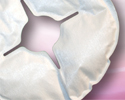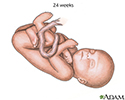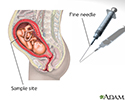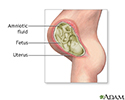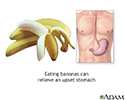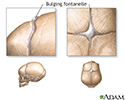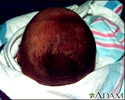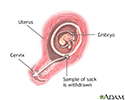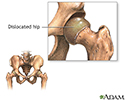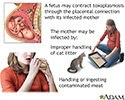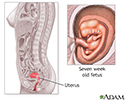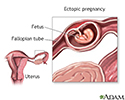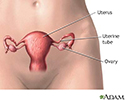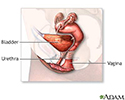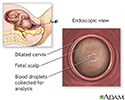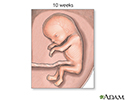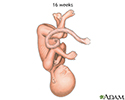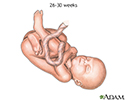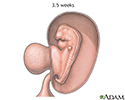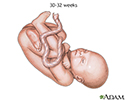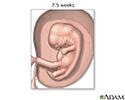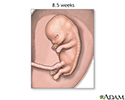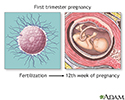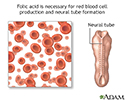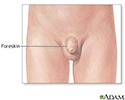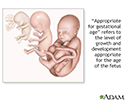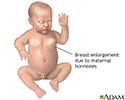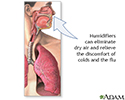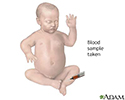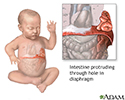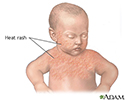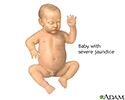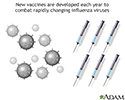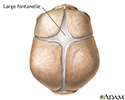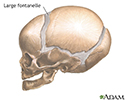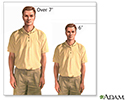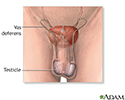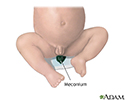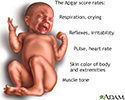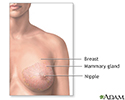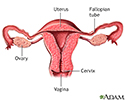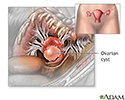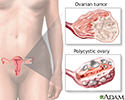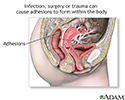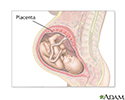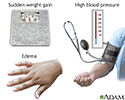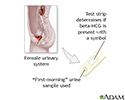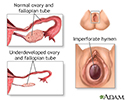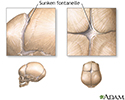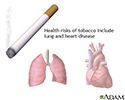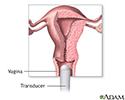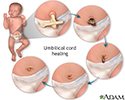Multimedia Gallery
Placenta formation
Many people have mistaken ideas about how a growing embryo eats and breathes in the uterus.
From the earliest stages of its development, the growing embryo requires nutrition and oxygen, and a disposal system for the waste products of its own metabolism. All of this is accomplished by the placenta, which allows the growing embryo to eat and breathe while in the mother's uterus.
To get some perspective on how the placenta began, let's go back to Day 8. This hollow ball of cells moving through the uterus is the blastocyst, searching for an implantation site. Here you see its outer layer beginning to extend out and implant in the uterine lining, searching for the uterine blood vessels that would nourish it throughout the pregnancy.
As it went deeper, a single layer of cells from the mother's uterine lining surrounded it, so that it would be protected from harm. On Day 9, as it grew larger and more complex, the blastocyst became an embryo. Here it's about the size of a pinhead.
Also on Day 9, the outer layer of the embryo developed spaces called lacunae. The lacunae filled up with blood from the mother's uterine lining.
On Day 13, small projections from the embryo's chorionic layer reached out into the uterine lining. The chorionic layer is one of the membranes that surround the embryo and help it implant.
On Days 15 through 21, blood vessels began to form beneath this chorionic layer.
Around Day 21, the embryo's blood stream and the mother's blood stream were in such close contact that nutrients and oxygen could cross from mother to embryo. This was how the embryo first got its food and air from the mother, and technically this is when the placenta began to function.
Let's magnify this area so you can see what we're talking about. Here you see a vein and an artery from the embryo in close contact with the blood in the mother's uterine lining. Inside the blood vessels, you can also see red blood cells, which carry oxygen.
The two blood streams are separated by a thin collection of tissues in the placenta called the blood barrier. This barrier permits small particles like nutrients and oxygen to pass from the mother to the embryo, and allows waste products to pass from the embryo back to the mother. The blood barrier also prevents many large or potentially harmful particles from entering the embryo's blood stream. Notice that the red blood cells do not cross from the mother's blood stream to the embryo's.
You may be wondering how a mother's blood cells could be harmful to her growing baby, and why it's important to keep the two blood streams separate. If the mother's blood type is RH negative, and her embryo's blood type is RH positive, then the mother's antibodies would treat the embryo as an invading foreign organism, and try to destroy it.
Now you can see why the placenta and its blood barrier are important for supplying the growing embryo with nutrition and oxygen, removing its waste products, and preventing harmful substances from getting into its blood stream.
Placenta formation
Review Date: 8/23/2023
Reviewed By: LaQuita Martinez, MD, Department of Obstetrics and Gynecology, Emory Johns Creek Hospital, Alpharetta, GA. Also reviewed by David C. Dugdale, MD, Medical Director, Brenda Conaway, Editorial Director, and the A.D.A.M. Editorial team.
Animations
- Breast engorgement
- Cell division
- Cesarean section
- Conception - general
- Conception - pregnancy
- Conception of identical twins
- C-section
- Early labor
- Egg cell production
- Egg production
- Endometriosis
- Fetal ear development
- Formation of twins
- Human face formation
- Infant formulas
- Kids - How big is the baby?
- Kids - How does the baby co...
- Kids - Is it a girl or boy?
- Kids - Umbilical cord
- Kids - Where do babies come...
- Newborn jaundice
- NICU consultants and suppor...
- Ovulation
- Placenta delivery
- Placenta formation
- Preeclampsia
- Pregnancy
- Pregnancy care
- Sperm production
- Sperm release pathway
- Storing breast milk
- The role of amniotic fluid
- Twin-to-twin transfusion sy...
- Ultrasound
- Vaginal delivery
Illustrations
- 24-week fetus
- Abnormal discharge from the...
- Abnormal menstrual periods
- Absence of menstruation (am...
- Amniocentesis
- Amniocentesis
- Amniotic fluid
- Amniotic fluid
- Anatomy of a normal placenta
- Antibodies
- Baby burping position
- Bananas and nausea
- Blood cells
- Blood test
- Breast infection
- Breastfeeding
- Bulging fontanelles
- Candida - fluorescent stain
- Caput succedaneum
- Cesarean section
- Cesarean section
- Cesarean section
- Childbirth
- Chorionic villus sampling
- Congenital hip dislocation
- Congenital toxoplasmosis
- Crying - excessive (0 to 6 ...
- Delivery presentations
- Developmental milestones
- Early weeks of pregnancy
- Ectopic pregnancy
- Emergency Childbirth
- Emergency Childbirth
- Endocrine glands
- Endometriosis
- Endometritis
- Erythroblastosis fetalis - ...
- Female breast
- Female reproductive anatomy
- Female reproductive anatomy
- Female reproductive anatomy...
- Female urinary tract
- Fetal blood testing
- Fetal head molding
- Fetus at 10 weeks
- Fetus at 12 weeks
- Fetus at 16 weeks
- Fetus at 26 to 30 weeks
- Fetus at 3.5 weeks
- Fetus at 30 to 32 weeks
- Fetus at 7.5 weeks
- Fetus at 8.5 weeks
- First trimester of pregnancy
- Folic acid
- Folic acid benefits
- Folic acid source
- Follicle development
- Fontanelles
- Foreskin
- Gestational ages
- Gestational diabetes
- Gonadotropins
- Head circumference
- Heat rash
- Height/weight chart
- Hormonal effects in newborns
- Humidifiers and health
- Hysterectomy
- Infant blood sample
- Infant care following delivery
- Infant diaphragmatic hernia
- Infant heat rash
- Infant intestines
- Infant jaundice
- Infantile reflexes
- Influenza vaccines
- Intraductal papilloma
- Intrauterine transfusion
- Jaundiced infant
- Large fontanelles
- Large fontanelles (lateral view)
- Macrosomia
- Male reproductive anatomy
- Male reproductive anatomy
- Male urinary tract
- Mammary gland
- Meconium
- Morning sickness
- Moro reflex
- Newborn head molding
- Newborn test
- Normal female breast anatomy
- Normal uterine anatomy (cut...
- Ovarian cyst
- Ovarian hypofunction
- Overproductive ovaries
- Pelvic adhesions
- Pelvic laparoscopy
- Placenta
- Placenta
- Placenta
- Placenta previa
- Polyhydramnios
- Preeclampsia
- Pregnancy test
- Primary amenorrhea
- Primary infertility
- Secondary amenorrhea
- Secondary infection
- Side sectional view of fema...
- Single palmar crease
- Skull of a newborn
- Slit-lamp exam
- Sperm
- Stein-Leventhal syndrome
- Sunken fontanelles (superio...
- Tobacco health risks
- Transvaginal ultrasound
- Ultrasound in pregnancy
- Ultrasound, color - normal ...
- Ultrasound, normal fetus - ...
- Ultrasound, normal fetus - ...
- Ultrasound, normal fetus - ...
- Ultrasound, normal fetus - face
- Ultrasound, normal fetus - ...
- Ultrasound, normal fetus - foot
- Ultrasound, normal fetus - ...
- Ultrasound, normal fetus - ...
- Ultrasound, normal fetus - ...
- Ultrasound, normal fetus - ...
- Ultrasound, normal placenta...
- Ultrasound, normal relaxed ...
- Umbilical cord healing
- Uterus
- Vaginal bleeding during pre...
- Well baby visits
- Yeast infections

 Bookmark
Bookmark



























